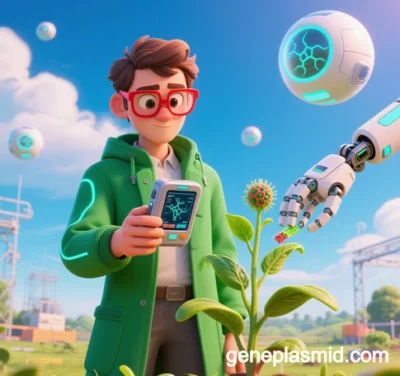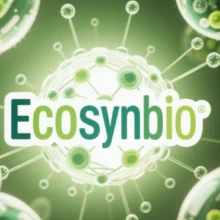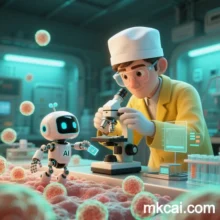
Gene Plasmids: Core Achievements and Future Prospects in Gene Therapy, Vaccine Development, and Agricultural Breeding
Gene plasmids, a cornerstone of biotechnology, have driven breakthroughs in gene therapy, vaccine development, and agricultural breeding, with transformative potential for cross-disciplinary integration and industrialization. Below, we analyze their technical achievements, applications, and future directions.
I. Gene Therapy: From Vector Design to Clinical Translation
1. Key Achievements
- Gene Delivery Innovation:
Non-integrating plasmids optimized with promoters (e.g., CMV, EF1α) and regulatory elements (e.g., WPRE, miRNA targets) enhance therapeutic gene expression and persistence. In CAR-T therapy, plasmids encoding chimeric antigen receptors (e.g., CD19/CD22) achieve over 80% complete remission in B-cell lymphoma via electroporation. - Precision Editing: CRISPR-Cas9 delivered via plasmids restores DMD reading frames in Duchenne muscular dystrophy models, rescuing dystrophin function.
- Safety Enhancements: Antibiotic resistance-free plasmids (e.g., ori-free vectors) reduce horizontal gene transfer risks. Self-replicating plasmids (SV40 ori-based) lower therapeutic gene doses by 90%, minimizing immunogenicity.
2. Future Directions
- Targeted Delivery: Hybrid systems combining tissue-specific promoters (e.g., liver-targeted TBG) and synthetic capsids (e.g., AAV-PHP.eB) improve organ-specific plasmid enrichment.
- In Vivo Editing: Lipid nanoparticles (LNPs) encapsulating plasmid-RNP complexes enable single-dose PCSK9 knockout in hepatocytes, reducing LDL levels by 60%.
- Scalable Production: Continuous fermentation and membrane chromatography achieve gram-scale GMP plasmid yields at under $50/mg, democratizing gene therapies.
II. Vaccine Development: From DNA Vaccines to mRNA Platforms
1. Key Achievements
- DNA Vaccine Optimization: Codon-optimized plasmids with CpG motifs boost antigen expression and immunogenicity. The Zika DNA vaccine (GLS-5700) induces 10x higher neutralizing antibodies than inactivated vaccines.
- mRNA Template Role: Supercoiled plasmids (>90% purity) serve as templates for IVT mRNA production, with Pfizer-BioNTech’s COVID-19 vaccine requiring 0.1 mg plasmid per dose.
- Multivalent Vaccines: Plasmids with multi-cloning sites (MCS) encode antigens from pathogens like HIV (Gag/Pol/Nef), covering over 90% of viral variants.
2. Future Directions
- Self-Amplifying RNA: Alphavirus replicase genes (e.g., VEEV nsP1-4) in plasmids enable intracellular mRNA replication, boosting antigen expression 100x for single-dose immunity.
- Thermostable Vaccines: Lyophilized plasmid-DNA vaccines (e.g., INO-4800) using trehalose stabilize at room temperature for tropical distribution.
- Mucosal Immunity: Nasal spray plasmids (e.g., AG0302) with chitosan nanoparticles trigger sIgA antibodies to block viral entry.
III. Agricultural Breeding: From Stress Resistance to Synthetic Biology
1. Key Achievements
- Disease Resistance: Binary vectors (e.g., pCAMBIA) deliver Bt toxin and Xa21 genes to rice and maize, cutting crop losses by 40–60%. CRISPR plasmids edit OsNramp5 to create low-cadmium rice (<0.01 mg/kg).
- Photosynthetic Efficiency: Introducing maize PEPC into rice via plasmids increases Rubisco activity by 30%, boosting yields by 15%.
- Synthetic Biology: Golden Gate-assembled plasmids engineer microbial taxadiene pathways, scaling anticancer precursor yields from 1 mg/L to 1 g/L.
2. Future Directions
- Gene Drives: Plasmid-based CRISPR-Cas9 systems spread malaria resistance genes (e.g., FBN9) in mosquitoes, achieving 99% field efficacy.
- Non-GMO Breeding: Transient plasmids (e.g., virus-induced silencing vectors) epigenetically regulate traits like flowering time without genomic edits.
- Vertical Farming: Chloroplast mini-chromosomes with RBCS/LHCB genes enhance light-use efficiency in lettuce and spinach, quintupling yields under artificial lighting.
IV. Cross-Disciplinary Synergies and Challenges
1. Emerging Trends
- AI-Driven Design: Deep learning models (e.g., AlphaFold 3) predict plasmid-host interactions, tripling E. coli plasmid yields via optimized ori-RNA polymerase compatibility.
- Ecological Engineering: Phage-engineered plasmids deliver nif gene clusters to soil microbiomes, slashing synthetic fertilizer use by 50%.
2. Critical Challenges
- Delivery Efficiency: Sub-1% nuclear localization rates demand improved NLS algorithms and microfluidic electroporation for >80% transfection.
- Ethics and Governance: Gene drive plasmids require “daisy-chain” biocontainment and global tracking databases (e.g., GOSHIBA) to mitigate ecological risks.
V. Conclusion
Gene plasmids have evolved from simple tools to cross-disciplinary engines: enabling programmable repair in gene therapy, modular vaccine production, and eco-conscious crop design. Future integration with synthetic biology and quantum computing (e.g., simulating plasmid folding) could enable ultra-high-throughput design-to-validation pipelines, slashing R&D cycles from months to days. However, sustainable progress demands alignment with biosafety and ethical frameworks to usher in the “Plasmid 2.0” era.
Data sourced from public references. Contact: chuanchuan810@gmail.com.





